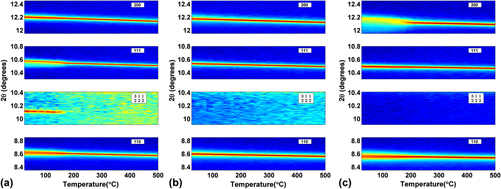Crossref Citations
This article has been cited by the following publications. This list is generated based on data provided by
Crossref.
Dittmer, Robert
Anton, Eva‐Maria
Jo, Wook
Simons, Hugh
Daniels, John E.
Hoffman, Mark
Pokorny, Jan
Reaney, Ian M.
Rödel, Jürgen
and
Damjanovic, D.
2012.
A High‐Temperature‐Capacitor Dielectric Based on K0.5Na0.5NbO3‐Modified Bi1/2Na1/2TiO3–Bi1/2K1/2TiO3.
Journal of the American Ceramic Society,
Vol. 95,
Issue. 11,
p.
3519.
Gobeljic, Danka
Dittmer, Robert
Rödel, Jürgen
Shvartsman, Vladimir V.
Lupascu, Doru C.
and
Zhang, S.
2014.
Macroscopic and Nanoscopic Polarization Relaxation Kinetics in Lead‐Free Relaxors Bi1/2Na1/2TiO3–Bi1/2K1/2TiO3–BiZn1/2Ti1/2O3.
Journal of the American Ceramic Society,
Vol. 97,
Issue. 12,
p.
3904.
Dittmer, Robert
Jo, Wook
Webber, Kyle G.
Jones, Jacob L.
and
Rödel, Jürgen
2014.
Local structure change evidenced by temperature-dependent elastic measurements: Case study on Bi1/2Na1/2TiO3-based lead-free relaxor piezoceramics.
Journal of Applied Physics,
Vol. 115,
Issue. 8,
Bai, Wangfeng
Li, Lingyu
Li, Wei
Shen, Bo
Zhai, Jiwei
Chen, Haydn
and
Kleebe, H.‐J.
2014.
Phase Diagrams and Electromechanical Strains in Lead‐Free BNT‐Based Ternary Perovskite Compounds.
Journal of the American Ceramic Society,
Vol. 97,
Issue. 11,
p.
3510.
Reichmann, Klaus
Feteira, Antonio
and
Li, Ming
2015.
Bismuth Sodium Titanate Based Materials for Piezoelectric Actuators.
Materials,
Vol. 8,
Issue. 12,
p.
8467.
Fei, Lanbing
Shi, Danping
Huang, Yanming
and
Liu, Laijun
2015.
Low dielectric loss and good thermal stability of Eu and Ti co-doped K0.5Na0.5NbO3 ceramics.
Journal of Materials Science: Materials in Electronics,
Vol. 26,
Issue. 9,
p.
7159.
Ehara, Yoshitaka
Novak, Nikola
Yasui, Shintaro
Itoh, Mitsuru
and
Webber, Kyle G.
2015.
Electric-field-temperature phase diagram of Mn-doped Bi0.5(Na0.9K0.1)0.5TiO3 ceramics.
Applied Physics Letters,
Vol. 107,
Issue. 26,
Ayrikyan, Azatuhi
Rojas, Virginia
Molina-Luna, Leopoldo
Acosta, Matias
Koruza, Jurij
and
Webber, Kyle G.
2015.
Enhancing electromechanical properties of lead-free ferroelectrics with bilayer ceramic/ceramic composites.
IEEE Transactions on Ultrasonics, Ferroelectrics, and Frequency Control,
Vol. 62,
Issue. 6,
p.
997.
Quiroga, David Antonio Barbosa
Albornoz Diaz, Julio Cesar Camilo
Venet, Michel
Rodrigues, Ariano De Giovanni
Florêncio, Odila
and
da Silva, Paulo Sergio
2017.
Evolution of crystalline phases and morphotropic phase boundary of the (Bi,Na)TiO3-(Bi,K)TiO3-BaTiO3 lead-free ceramic system.
Journal of Alloys and Compounds,
Vol. 691,
Issue. ,
p.
498.
Jain Ruth, D. E.
and
Sundarakannan, B.
2017.
A correlative study on strain and variation of coercive field in lead-free (Na0.5Bi0.5)TiO3–Bi(Mg0.5Zr0.5)O3–Bi(Mg0.5Ti0.5)O3 ternary system.
Journal of Materials Science: Materials in Electronics,
Vol. 28,
Issue. 21,
p.
15907.
Sun, Hailing
Chan, Yi Lok
and
Kwok, K. W.
2019.
Electric field-responsive photoluminescence color switching and reversible propertiesviaTb/Eu co-doped ergodic relaxor ferroelectrics.
Physical Chemistry Chemical Physics,
Vol. 21,
Issue. 14,
p.
7567.
Zeng, Liang
and
Zhou, Ji
2019.
Quantitative phase analyses of Eu3+ -doped (Na1-,K )0.5Bi0.5TiO3ferroelectric ceramics near morphotropic phase boundary by photoluminescence spectra.
Ceramics International,
Vol. 45,
Issue. 13,
p.
15913.
Duraisamy, Dhayanithi
and
Venkatesan, Giridharan Nambi
2020.
Observation of enhanced electrostrictive strain in (1-2x)Na0.5Bi0.5TiO3-xBaTiO3-xBiAlO3 lead-free ceramics.
Sensors and Actuators A: Physical,
Vol. 315,
Issue. ,
p.
112307.
Muhammed, Khalid Rmaydh
Scrimshire, Alex
Sterianou, Iasmi
Bell, Anthony M. T.
and
Bingham, Paul A.
2020.
Physical properties and sinterability of pure and iron-doped bismuth sodium titanate ceramics.
Journal of the Australian Ceramic Society,
Vol. 56,
Issue. 4,
p.
1441.
Liu, Binzhi
and
Tan, Xiaoli
2021.
Structure, ferroelectric, and dielectric properties of (Na1−2xCax)NbO3 ceramics.
Journal of Materials Research,
Vol. 36,
Issue. 5,
p.
1076.
Liu, Xin
Song, Wenjie
Wu, Mei
Yang, Yuben
Yang, Ying
Lu, Peipei
Tian, Yinhua
Sun, Yuanwei
Lu, Jingdi
Wang, Jing
Yan, Dayu
Shi, Youguo
Sun, Nian Xiang
Sun, Young
Gao, Peng
Shen, Ka
Chai, Guozhi
Kou, Supeng
Nan, Ce-Wen
and
Zhang, Jinxing
2021.
Magnetoelectric phase transition driven by interfacial-engineered Dzyaloshinskii-Moriya interaction.
Nature Communications,
Vol. 12,
Issue. 1,
Bremecker, Daniel
Lalitha, K. V.
Teuber, Siegfried
Koruza, Jurij
and
Rödel, Jürgen
2022.
Influence of Zn2+ doping on the morphotropic phase boundary in lead‐free piezoelectric (1 – x)Na1/2Bi1/2TiO3‐xBaTiO3.
Journal of the American Ceramic Society,
Vol. 105,
Issue. 2,
p.
1232.
Sharma, Ankur
Yadav, Pinki
Bhaumik, Indranil
Singh, M. N.
Sathe, Vasant
and
Singh, Gurvinderjit
2023.
Structural evaluation in vicinity of composition induced non-ergodic to ergodic crossover in niobium doped (Na0.41K0.09Bi0.5)TiO3.
Journal of Applied Physics,
Vol. 134,
Issue. 4,
Kan, Akinori
Araki, Kentaro
and
Ogawa, Hirotaka
2023.
Effect of bismuth deficiency with K substitution for Na on piezoelectric properties and crystal structure of Bi0.5−(Na0.8−K0.2+)0.5TiO3–3/2 (0 ≤ x ≤ 0.015, 0 ≤ y ≤ 0.1) ceramics.
Journal of Alloys and Compounds,
Vol. 968,
Issue. ,
p.
172089.



